In a world teeming with over 10,000 bird species, some of the most adorable feathered creatures remain hidden from mainstream attention. While penguins, owls, and hummingbirds often steal the spotlight, numerous lesser-known avian gems possess charm and cuteness that rival internet cat videos. These overlooked birds, with their peculiar behaviors, diminutive sizes, and distinctive appearances, deserve recognition in the gallery of nature’s most endearing creations. From tiny fluffballs that fit in the palm of your hand to birds with facial expressions that seem almost cartoon-like, these underappreciated species demonstrate nature’s incredible imagination and diversity. Join us on this ornithological journey as we explore some of the world’s most adorable yet unfamiliar feathered friends.
The Eurasian Wren: Tiny Powerhouse of Song
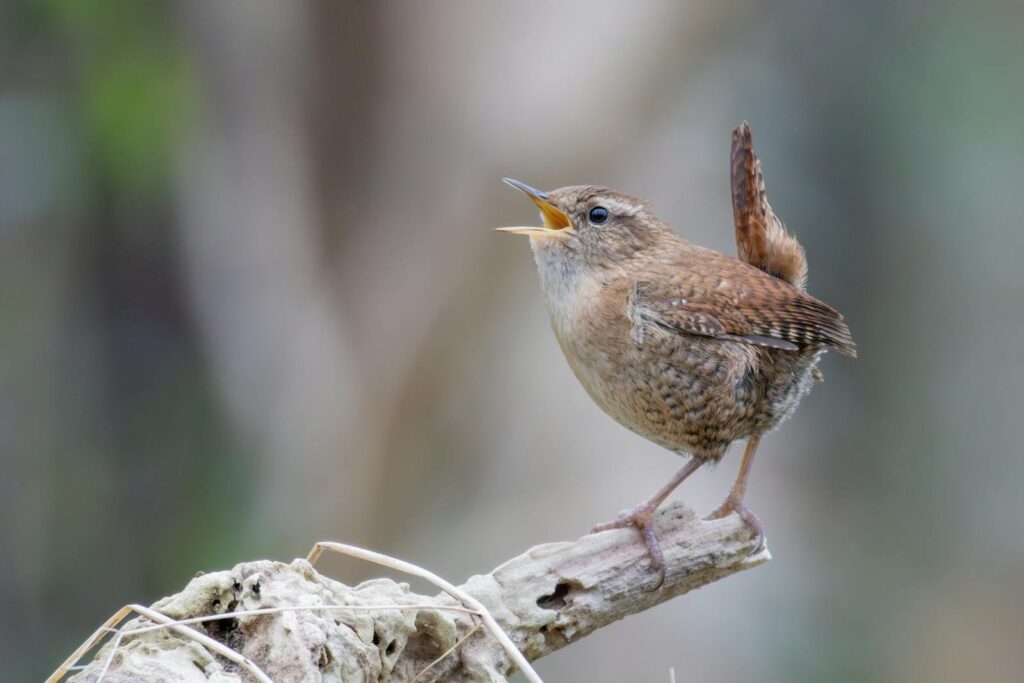
The Eurasian Wren (Troglodytes troglodytes) might be one of Europe’s smallest birds, weighing just 10 grams, but what it lacks in size it makes up for in vocal prowess and charm. This tiny brown bird with its characteristic upturned tail produces a song remarkably loud for its diminutive stature, often belting out notes ten times more powerful than expected from its tiny frame. During breeding season, male wrens build multiple dome-shaped nests from moss, leaves, and grass, inviting females to inspect their handiwork before choosing their preferred home. Their round bodies, coupled with inquisitive eyes and almost constantly vibrating tails, give them an endearingly energetic appearance that seems to defy their tiny proportions. Despite being common across Europe, these minute birds often go unnoticed as they dart through undergrowth and along forest floors, their mouse-like movements keeping them hidden from casual observers.
The Japanese Waxwing: Masked Marvel of the Orient
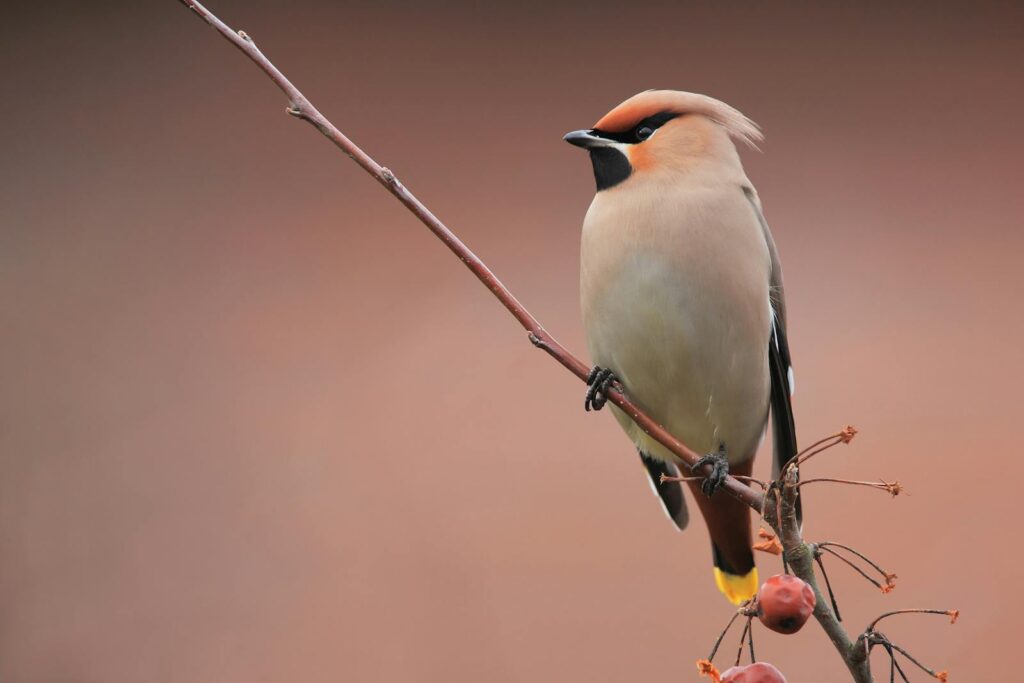
With its striking black mask and crest contrasting against soft gray-brown plumage, the Japanese Waxwing (Bombycilla japonica) looks like a bird wearing an elegant costume. This medium-sized songbird sports distinctive red waxy tips on its wing feathers that resemble drops of sealing wax, giving the species its evocative name. Endemic to northeastern Asia, these birds exhibit charming social behaviors, often forming tight-knit flocks that move through forested areas in search of berries and fruits. Their expressive faces, highlighted by black eye masks and subtle yellow markings, give them an almost theatrical appearance that photographers and birdwatchers cherish. During winter months, these birds occasionally appear in unexpected locations during irruptive years, creating excitement among birders who glimpse their distinctive silhouettes against winter skies.
The Long-tailed Tit: Cotton Ball with a Tail
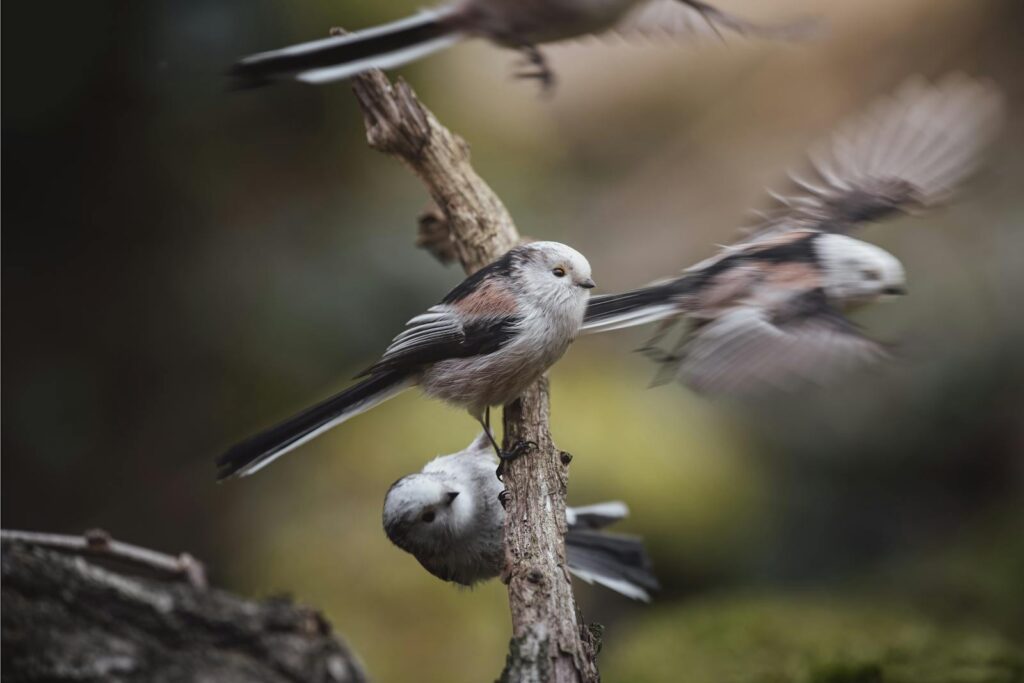
Resembling animated cotton balls with impossibly long tails, Long-tailed Tits (Aegithalos caudatus) rank among Europe’s most adorable avian residents. These tiny birds weigh just 7-9 grams but sport tails that often exceed the length of their bodies, creating a distinctive silhouette as they bounce between branches. Their round bodies covered in fluffy pinkish-white and black plumage give them an almost toy-like appearance that belies their remarkable resilience in harsh weather. Perhaps most endearing is their highly social nature and cooperative breeding system, where siblings from previous broods help parents raise new chicks, forming tight family units that roost together in adorable fluffy balls during cold nights. During nest building, a pair will construct an elaborate elastic dome made from up to 2,000 feathers, moss, and spider webs, creating one of the most complex and beautiful nests in the bird world.
The Philippine Eagle-Owl: Teddy Bear of the Raptor World
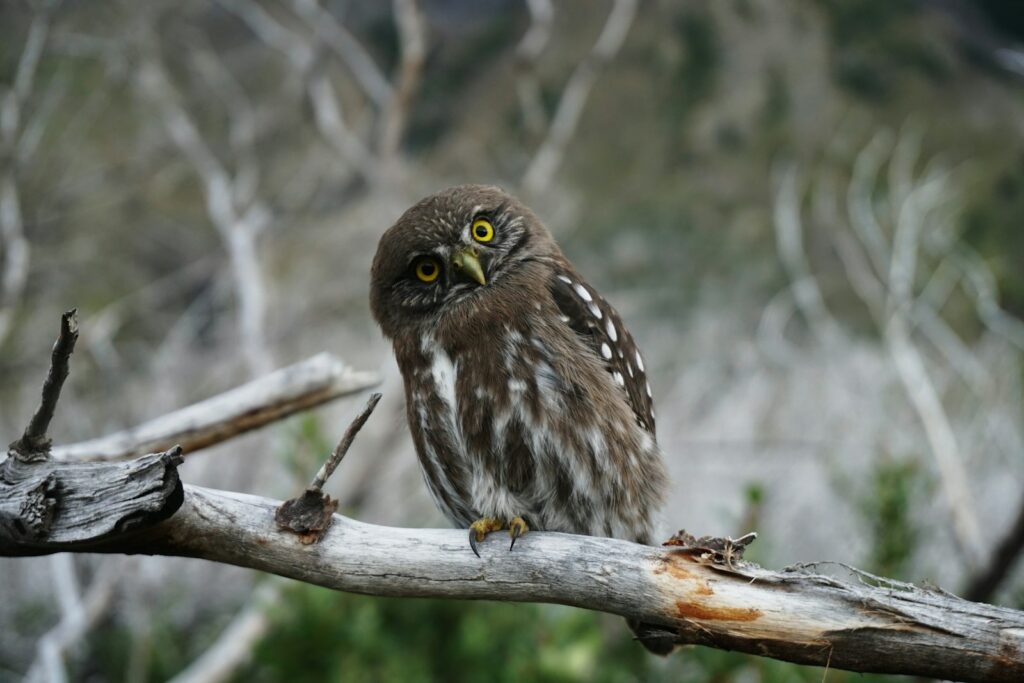
While owls generally enjoy popularity for their cuteness, the Philippine Eagle-Owl (Bubo philippensis) remains largely unknown despite being perhaps the most huggable-looking of all raptors. Endemic to the Philippines, this medium-sized owl sports enormous round orange eyes set against facial disks that create an expression of perpetual surprise. Its plush-looking feathers, rust-colored plumage, and prominent “ear” tufts give it the appearance of a stuffed animal come to life rather than a formidable nocturnal predator. Unfortunately, this adorable species faces significant conservation challenges, with habitat loss and illegal wildlife trade threatening its survival across its limited island range. Unlike many other owl species that have adapted to human environments, this forest-dependent species requires intact woodland ecosystems, making conservation efforts particularly crucial for ensuring future generations can appreciate its teddy bear-like charm.
The Araripe Manakin: Cartoon Bird Come to Life
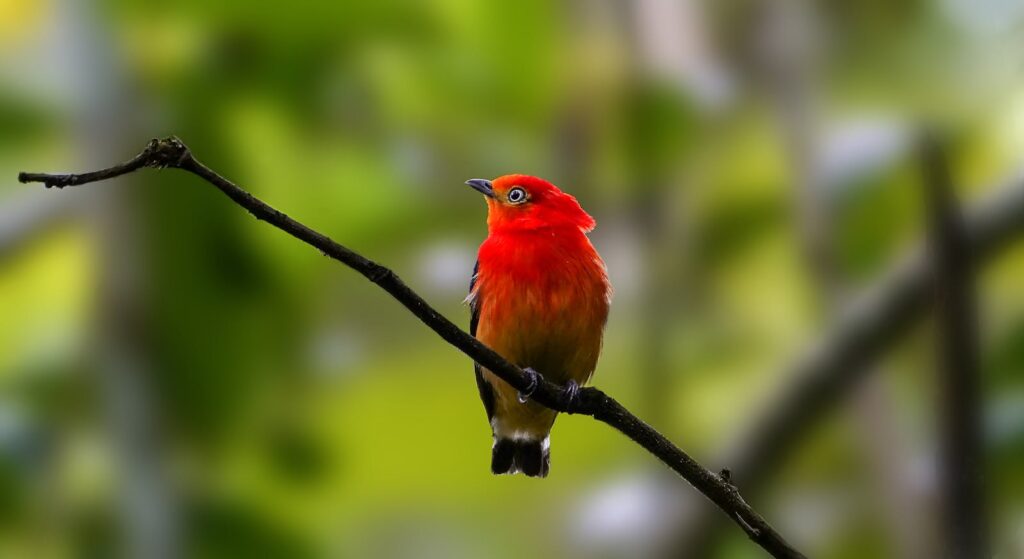
The Araripe Manakin (Antilophia bokermanni) of Brazil appears to have been designed by an artist rather than through natural evolution, with its snow-white body, jet-black wings and tail, and a striking crimson head crest that seems to defy gravity. Discovered only in 1996 and critically endangered, this bird’s range is restricted to less than 11 square miles in northeastern Brazil, making it one of the rarest and most range-restricted birds on Earth. Male manakins perform elaborate courtship displays, dancing along branches with clockwork precision and making mechanical-sounding calls to attract females. Their cartoon-like appearance combines with these charming behaviors to create a bird that seems almost too cute and colorful to be real. Conservation efforts center around protecting the specialized forest habitat around springs where these birds build their nests and raise their young.
The Spoon-billed Sandpiper: Tiny Bird with an Unusual Bill
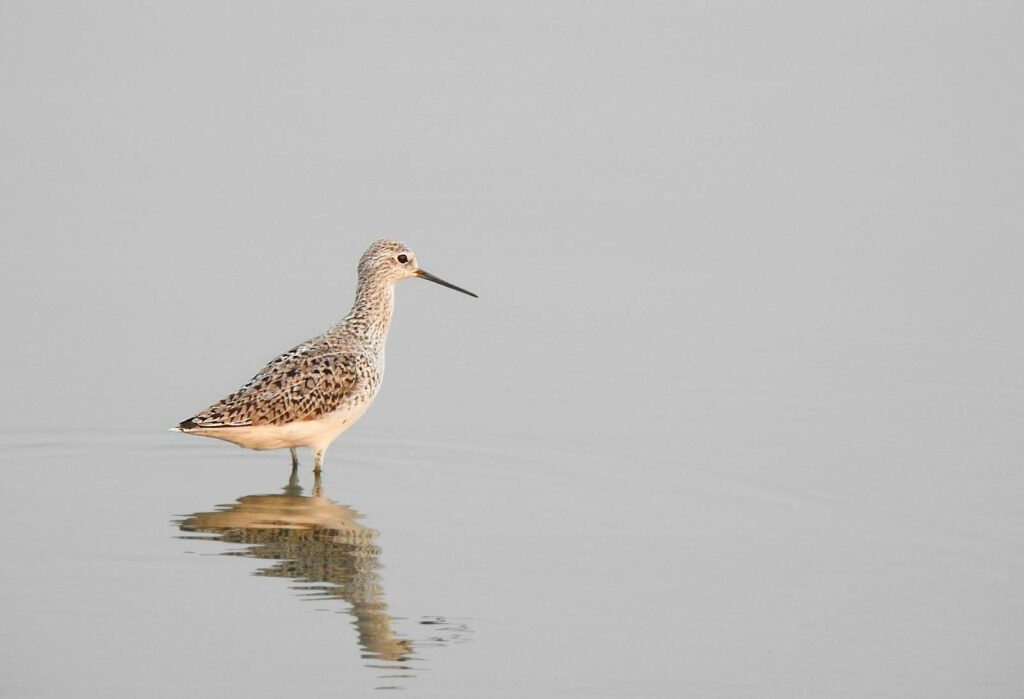
The critically endangered Spoon-billed Sandpiper (Calidris pygmaea) possesses one of the most distinctive and endearing features in the bird world—a spatula-shaped bill that seems almost comically oversized for its tiny body. These diminutive waders stand just 14-16 cm tall and weigh around 30 grams, making their specialized bills all the more prominent and charming. During breeding season, they develop a reddish-brown head and neck, creating a striking contrast with their otherwise grayish-white plumage. These tiny birds make one of the most remarkable migrations on Earth, traveling over 8,000 kilometers between their breeding grounds in Russia and wintering areas in Southeast Asia. With fewer than 600 individuals remaining in the wild, intensive conservation efforts including captive breeding programs, are underway to save this uniquely adorable species from extinction.
The Cuban Tody: Living Jewel of the Caribbean
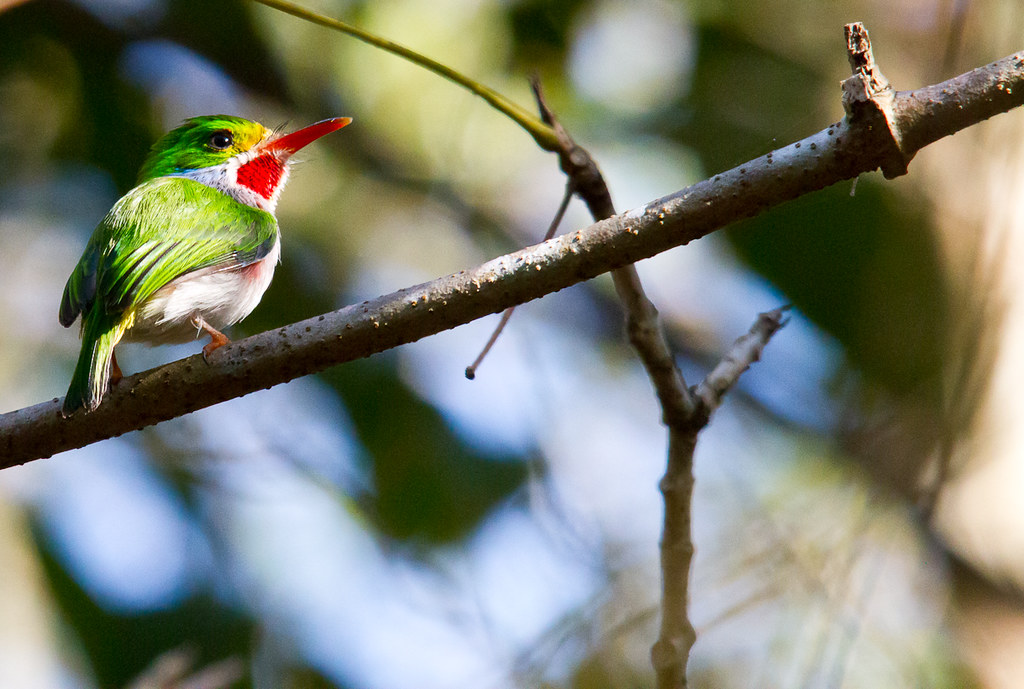
The Cuban Tody (Todus multicolor) packs an astonishing amount of color into its tiny 11 cm frame, sporting a brilliant green back, pink flanks, a red throat, yellow undertail, and a long, flattened bill that gives it a perpetually smiling appearance. These living jewels of Cuba’s forests hover like tiny helicopters while hunting insects, their wings beating so rapidly they create an audible whirring sound. Remarkably tame and seemingly curious about human observers, todies often allow close approach, tilting their heads inquisitively while studying visitors to their forest homes. They nest in tiny burrows excavated in earthen banks, where both parents take turns incubating eggs and feeding chicks, demonstrating admirable parental dedication despite their comical appearance. Local Cubans affectionately call them “pedorrera” (little farter) for the snorting sounds they make when clearing soil while digging their nesting tunnels.
The Shoebill: Adorably Prehistoric
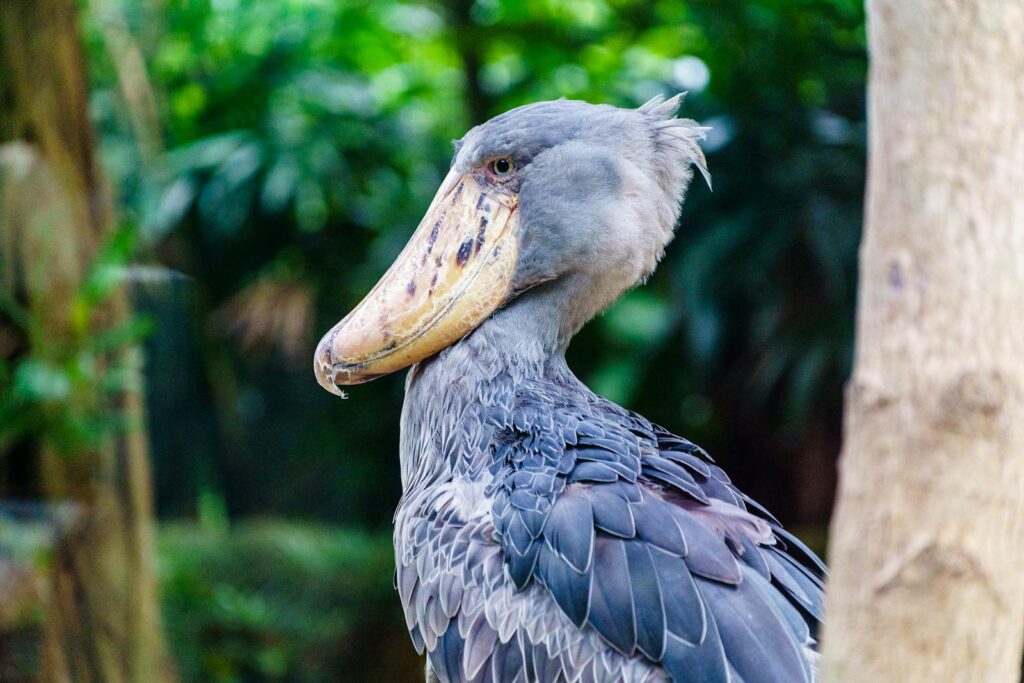
While initially intimidating due to its massive size and prehistoric appearance, the Shoebill (Balaeniceps rex) has gained internet fame for its surprisingly expressive face and endearing behaviors that contrast with its intimidating stature. Standing up to 1.5 meters tall, these enormous birds sport massive shoe-shaped bills that can seem menacing until you observe their slow, deliberate movements and almost comically patient hunting style. Perhaps most endearing is their habit of “bill-clapping,” a machine-gun-like rattling of their enormous bills that serves as both communication and greeting. Young Shoebills exhibit remarkably expressive faces, with large forward-facing eyes that give them an almost cartoon-like appearance of surprise or concern. Despite their size and prehistoric look, these birds demonstrate remarkable gentleness when interacting with their chicks and mates, revealing a softer side to their otherwise imposing presence.
The Crested Coua: Madagascar’s Glamorous Secret
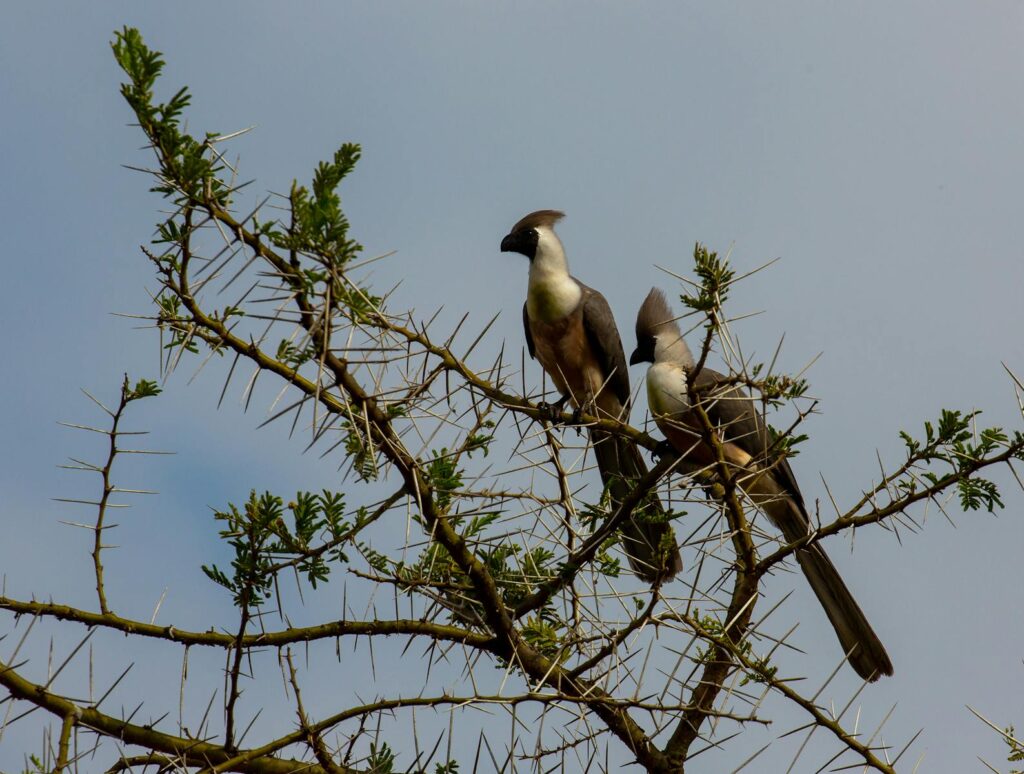
Madagascar’s Crested Coua (Coua cristata) combines elegance with an almost comical appearance, sporting a dramatic crest of feathers atop its head that resembles an eccentric hairstyle. What truly sets this bird apart are its striking blue facial skin patches surrounding extraordinarily long eyelashes that would make any mascara model envious. These ground-dwelling birds run rather than fly through Madagascar’s forests, using their long tails for balance as they dash between undergrowth in search of insects, fruits, and small reptiles. Perhaps their most endearing feature is their curious nature, as they often approach observers with obvious interest, cocking their heads to examine unfamiliar objects with their brilliant blue-ringed eyes. Coua chicks hatch with bizarrely patterned mouths that glow in the darkness of their nests, creating ghostly patterns that scientists believe help parents accurately target food during feeding in dimly lit nest cavities.
The Red-crowned Crane: Symbol of Longevity and Grace
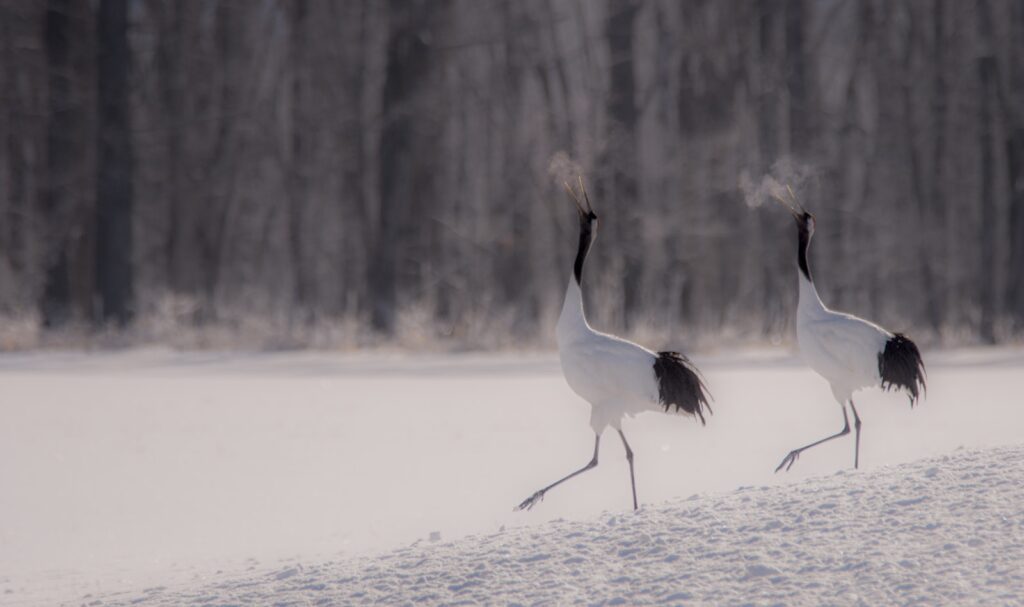
While somewhat better known in East Asian cultures, the Red-crowned Crane (Grus japonensis) remains unfamiliar to most Western audiences despite being one of the world’s most elegant and charismatic birds. Standing nearly five feet tall with snowy white plumage, black secondary feathers, and a distinctive crimson crown, these birds combine imposing presence with balletic grace. Their elaborate courtship dances, involving synchronized leaping, bowing, and wing-spreading, rank among nature’s most beautiful displays, inspiring artistic traditions across Japan, Korea, and China for centuries. Young cranes possess an adorable awkwardness as they learn these intricate dances, creating heartwarming moments as they practice alongside their patient parents. Despite their size and dignified appearance, these cranes demonstrate playful behaviors including tossing sticks, jumping with exuberance, and running with wings outstretched purely for the apparent joy of movement.
The Sri Lanka Frogmouth: Master of Disguise
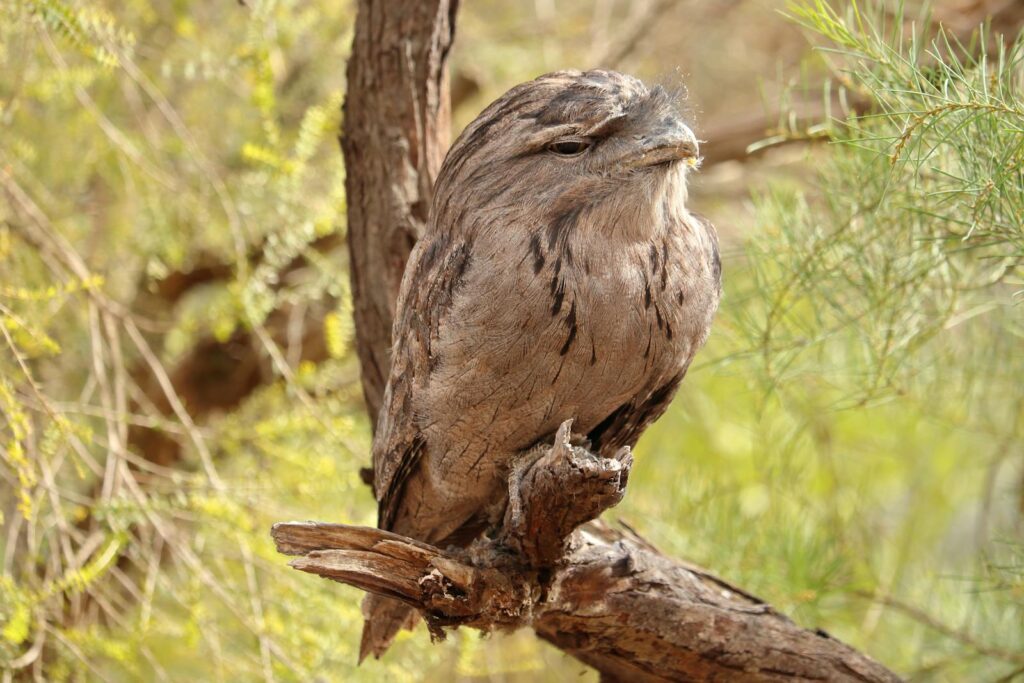
The Sri Lanka Frogmouth (Batrachostomus moniliger) perfectly embodies the concept of “so ugly it’s cute,” with its enormous gaping mouth, wide eyes, and mottled plumage creating an expression of perpetual astonishment. These nocturnal birds spend their days motionless, perfectly mimicking broken branches with their bark-colored feathers and unique posture that eliminates any bird-like silhouette. When threatened, frogmouths don’t flee but instead freeze, narrowing their eyes to slits and elongating their bodies to enhance their branch disguise, creating an adorably determined expression as they commit fully to their deception. Pairs are monogamous and highly devoted, often perching touching one another during daylight hours, their bodies pressed together in what appears to be a feathered embrace. Baby frogmouths look like tiny cotton balls with oversized mouths, their fluffy down and disproportionate features making them among the most endearingly awkward of all bird chicks.
The Southern Crowned Pigeon: Royal Blue Wonder
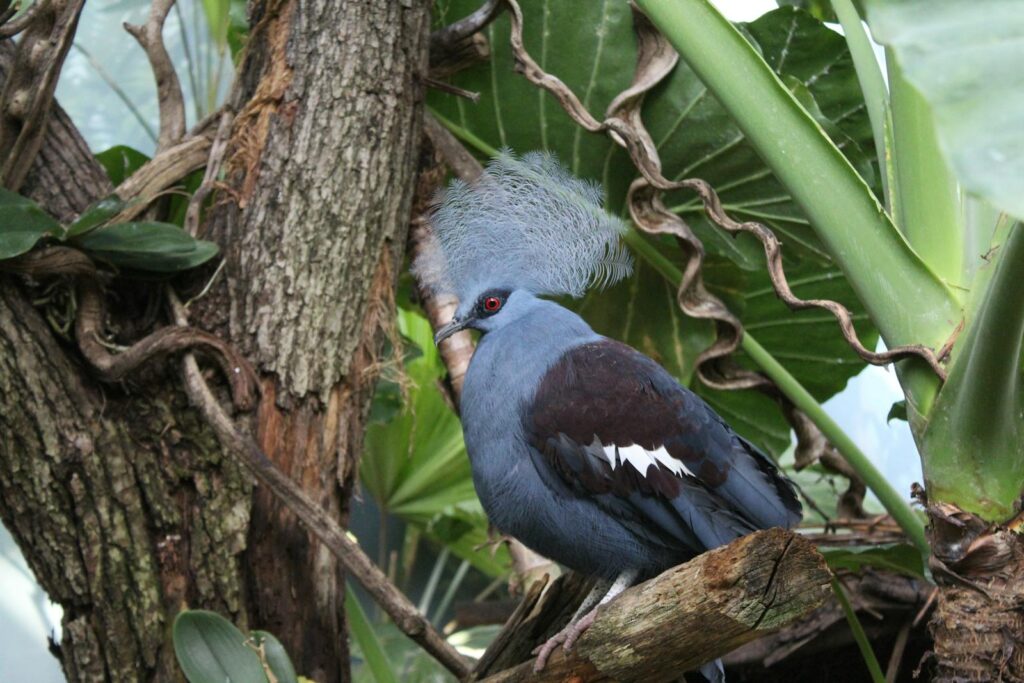
The Southern Crowned Pigeon (Goura scheepmakeri) defies all pigeon stereotypes, standing as the world’s largest pigeon species with its regal appearance and crown of lacy feathers that fan out like an elegant headdress. Native to New Guinea’s lowland forests, these birds sport powder-blue plumage, maroon chest patches, and ruby-red eyes that give them an almost mythical appearance. Despite their impressive size—reaching nearly 75 cm in length and weighing up to 2.5 kg—these birds move with surprising grace, walking delicately across the forest floor with the measured dignity of royalty. Their courtship involves deep bowing displays and soft, mournful calls that echo through the forest understory, behaviors that contrast charmingly with their imposing size. When relaxed, these majestic birds often fluff their feathers and settle onto perches with contented expressions that transform their regal appearance into something unexpectedly cuddly and approachable.
The Malayan Night Heron: Forest Floor Jewel
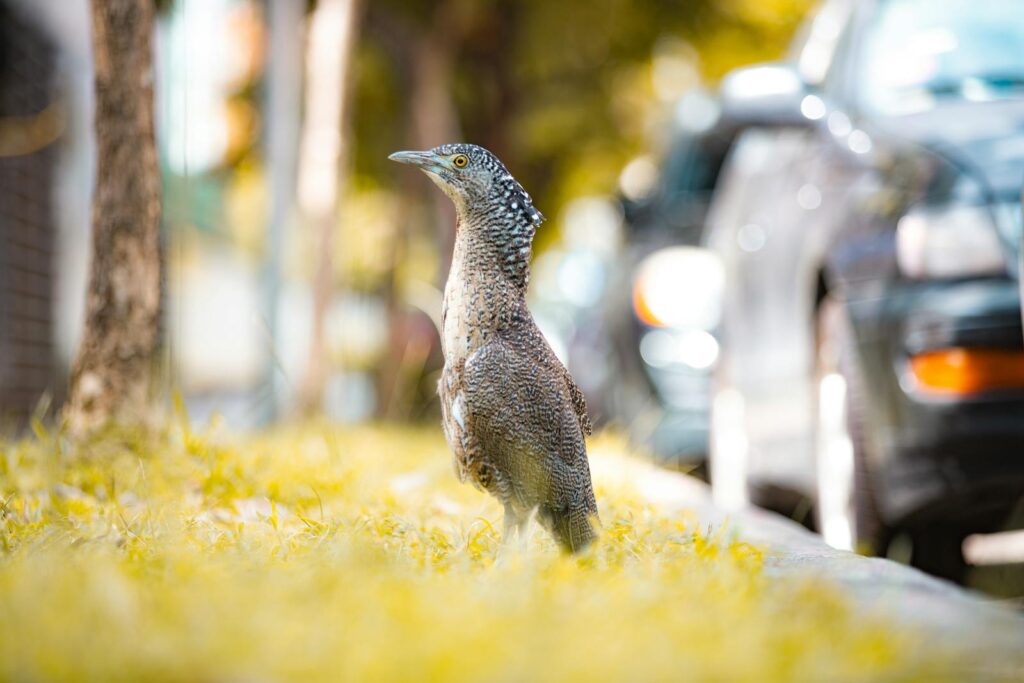
The Malayan Night Heron (Gorsachius melanolophus) combines the dignified stance of herons with the endearing qualities of a forest sprite, its stocky build and enormous eyes giving it a perpetually surprised expression. Unlike most herons that hunt in wetlands, this secretive species dwells on forested floors across Southeast Asia, its cinnamon-colored plumage and black crown creating perfect camouflage among fallen leaves. Young birds sport adorably spotted plumage with fluffy crests that stand erect when alarmed, making them look like surprised punk rockers with feathery mohawks. Perhaps most charming is their slow, deliberate walking style, placing each foot with extreme care while frequently freezing in mid-step when detecting observers, creating comical poses held with absolute seriousness. During breeding season, pairs perform elaborate greeting ceremonies, stretching their necks and pointing their bills skyward while swaying gently, a dignified dance that strengthens pair bonds between these secretive forest birds.
Conclusion
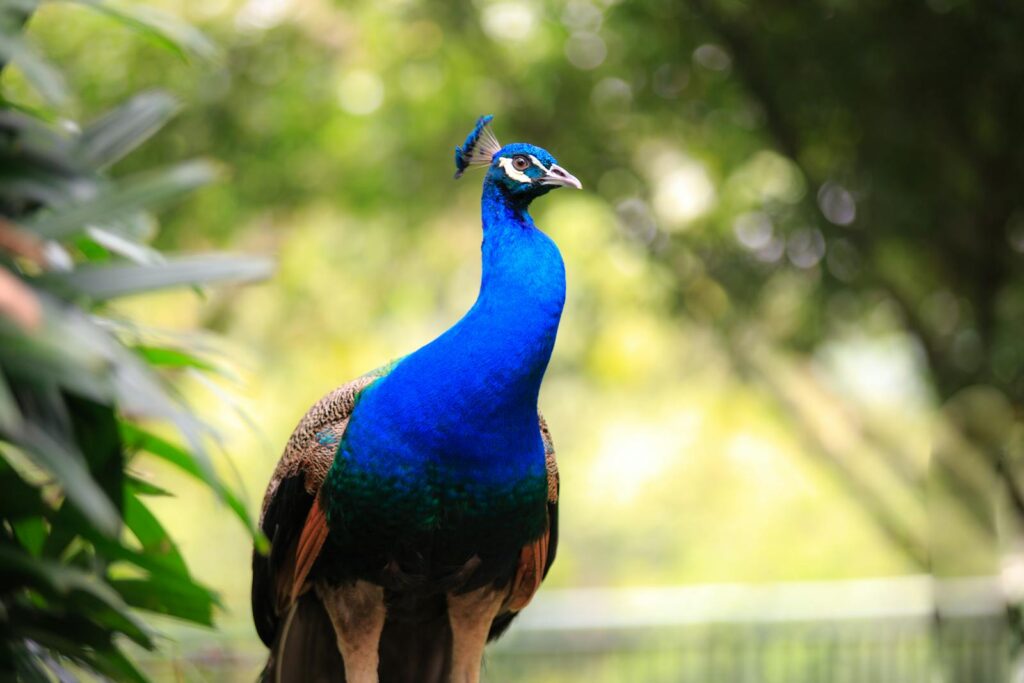
These remarkable birds represent just a tiny fraction of the incredible avian diversity that exists beyond familiar species. Each combines unique adaptations with undeniable charm, proving that nature’s capacity for creating endearing creatures extends far beyond the commonly celebrated species. From tiny fluffballs to imposing yet gentle giants, these birds demonstrate the extraordinary range of forms that evolution has produced across different environments and evolutionary pressures. As habitat loss and climate change threaten many of these species, appreciating their unique beauty becomes not just a source of joy but an important step toward ensuring their conservation. The next time you find yourself enchanted by a common robin or cardinal, remember that thousands of equally charming but lesser-known birds await discovery by anyone willing to look beyond the familiar feathered friends that typically capture our attention.
